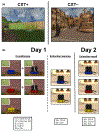A common genetic variant in fatty acid amide hydrolase is linked to alterations in fear extinction neural circuitry in a racially diverse, nonclinical sample of adults
- PMID: 34051704
- PMCID: PMC8628026
- DOI: 10.1002/jnr.24860
A common genetic variant in fatty acid amide hydrolase is linked to alterations in fear extinction neural circuitry in a racially diverse, nonclinical sample of adults
Abstract
Poor fear extinction learning and recall are linked to the development of fear-based disorders, like posttraumatic stress disorder, and are associated with aberrant activation of fear-related neural circuitry. This includes greater amygdala activation during extinction learning and lesser hippocampal and ventromedial prefrontal cortex (vmPFC) activation during recall. Emerging data indicate that genetic variation in fatty acid amide hydrolase (FAAH C385A; rs324420) is associated with increased peripheral endocannabinoid (eCB) levels and lesser threat-related amygdala reactivity. Preclinical studies link increased eCB signaling to better extinction learning and recall, thus FAAH C385A may protect against the development of trauma-related psychopathology by facilitating extinction learning. However, how this FAAH variant affects fear extinction neural circuitry remains unknown. In the present study, we used a novel, immersive-reality fear extinction paradigm paired with functional neuroimaging to assess FAAH C385A effects on fear-related neural circuitry and conditioned fear responding (US expectancy ratings, subjective units of distress, and skin conductance responding) in healthy adults from an urban area (Detroit, MI; N = 59; C/C = 35, A-carrier = 24). We found lesser amygdala activation in A-allele carriers, compared to C/C homozygotes, during early extinction recall. Likewise, we found lesser dorsal anterior cingulate cortex and greater hippocampus activation in early extinction learning in A-carriers compared to C/C homozygotes. We found no effects of FAAH C385A on vmPFC activation or behavioral fear indices. These data support and extend previous findings that FAAH genetic variation, associated with increased eCB signaling and subsequent enhanced fear extinction, may predict individual differences in successful fear learning.
Keywords: amygdala; aversive; endocannabinoids; genetic polymorphism; magnetic resonance imaging; prefrontal cortex.
© 2021 Wiley Periodicals LLC.
Conflict of interest statement
The authors do not have any conflict of interest to declare.
Figures







Similar articles
-
FAAH polymorphism (rs324420) modulates extinction recall in healthy humans: an fMRI study.Eur Arch Psychiatry Clin Neurosci. 2022 Dec;272(8):1495-1504. doi: 10.1007/s00406-021-01367-4. Epub 2021 Dec 10. Eur Arch Psychiatry Clin Neurosci. 2022. PMID: 34893921 Free PMC article.
-
The influence of FAAH genetic variation on physiological, cognitive, and neural signatures of fear acquisition and extinction learning in women with PTSD.Neuroimage Clin. 2022;33:102922. doi: 10.1016/j.nicl.2021.102922. Epub 2021 Dec 20. Neuroimage Clin. 2022. PMID: 34952353 Free PMC article.
-
Poor between-session recall of extinction learning and hippocampal activation and connectivity in children.Neurobiol Learn Mem. 2018 Dec;156:86-95. doi: 10.1016/j.nlm.2018.10.007. Epub 2018 Oct 19. Neurobiol Learn Mem. 2018. PMID: 30347237 Free PMC article.
-
Targeting the Endocannabinoid System in the Treatment of Posttraumatic Stress Disorder: A Promising Case of Preclinical-Clinical Translation?Biol Psychiatry. 2022 Feb 1;91(3):262-272. doi: 10.1016/j.biopsych.2021.07.019. Epub 2021 Jul 24. Biol Psychiatry. 2022. PMID: 34598785 Free PMC article. Review.
-
The endocannabinoid system in the amygdala and modulation of fear.Prog Neuropsychopharmacol Biol Psychiatry. 2021 Mar 8;105:110116. doi: 10.1016/j.pnpbp.2020.110116. Epub 2020 Sep 23. Prog Neuropsychopharmacol Biol Psychiatry. 2021. PMID: 32976951 Free PMC article. Review.
Cited by
-
FAAH polymorphism (rs324420) modulates extinction recall in healthy humans: an fMRI study.Eur Arch Psychiatry Clin Neurosci. 2022 Dec;272(8):1495-1504. doi: 10.1007/s00406-021-01367-4. Epub 2021 Dec 10. Eur Arch Psychiatry Clin Neurosci. 2022. PMID: 34893921 Free PMC article.
-
Developmental age and fatty acid amide hydrolase genetic variation converge to mediate fear regulation in female mice.Dev Psychobiol. 2023 Sep;65(6):e22409. doi: 10.1002/dev.22409. Dev Psychobiol. 2023. PMID: 37607892 Free PMC article.
-
Endocannabinoid dysregulation and PTSD in urban adolescents: Associations with anandamide concentrations and FAAH genotype.Psychopharmacology (Berl). 2024 Nov 16. doi: 10.1007/s00213-024-06717-3. Online ahead of print. Psychopharmacology (Berl). 2024. PMID: 39547971
-
The role of cannabinoids in shaping lifespan neurodevelopment.J Neurosci Res. 2022 Mar;100(3):709-712. doi: 10.1002/jnr.25012. Epub 2022 Feb 2. J Neurosci Res. 2022. PMID: 35106825 Free PMC article. No abstract available.
-
Dose-dependent effect of acute THC on extinction memory recall and fear renewal: a randomized, double-blind, placebo-controlled study.Psychopharmacology (Berl). 2024 Oct 16:10.1007/s00213-024-06702-w. doi: 10.1007/s00213-024-06702-w. Online ahead of print. Psychopharmacology (Berl). 2024. PMID: 39412674
References
-
- Beck AT, Steer RA, & Brown GK (1996). Beck depression inventory®-II (BDI®-II). Pearson.
-
- Bernier BE, Lacagnina AF, Ayoub A, Shue F, Zemelman BV, Krasne FB, & Drew MR (2017). Dentate gyrus contributes to retrieval as well as encoding: Evidence from context fear conditioning, recall, and extinction. Journal of Neuroscience, 37(26), 6359–6371. 10.1523/JNEUROSCI.3029-16.2017 - DOI - PMC - PubMed
Publication types
MeSH terms
Substances
Grants and funding
LinkOut - more resources
Full Text Sources
Other Literature Sources

